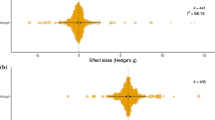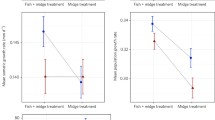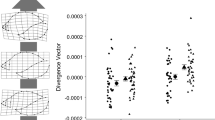Abstract
Most organisms possess traits that are sensitive to changes in the environment (i.e., plastic traits) which results in the expression of environmentally induced polymorphisms. While most phenotypically plastic traits have traditionally been treated as threshold switches between induced and uninduced states, there is growing evidence that many traits can respond in a continuous fashion. In this experiment we exposed larval anurans (wood frog tadpoles, Rana sylvatica) to an increasing gradient of predation risk to determine how organisms respond to small environmental changes. We manipulated predation risk in two ways: by altering the amount of prey consumed by a constant number of predators (Dytiscus sp.) and by altering the number of predators that consume a constant amount of prey. We then quantified the expression of predator-induced behavior, morphology, and mass to determine the level of risk that induced each trait, the level of risk that induced the maximal phenotypic response for each trait, whether the different traits exhibited a plateauing response, and whether increasing risk via increasing predator number or via increasing prey consumption induced similar phenotypic changes. We found that all of the traits exhibited fine-tuned, graded responses and most of them exhibited a plateauing response with increased predation risk, suggesting either a limit to plasticity or the reflection of high costs of the defensive phenotype. For many traits, a large proportion of the maximum induction occurred at low levels of risk, suggesting that the chemical cues of predation are effective at extremely low concentrations. In contrast to earlier work, we found that behavioral and morphological responses to increased predator number were simply a response to increased total prey consumption. These results have important implications for models of plasticity evolution, models of optimal phenotypic design, expectations for how organisms respond to fine-grained changes (i.e., within generation) in their environment, and impacts on ecological communities via trait-mediated indirect effects.


Similar content being viewed by others
References
Andersson S, Shaw RG (1994) Phenotypic plasticity in Crepis tectorum (Asteraceae): genetic correlations across light regimes. Heredity 72:113–125
Anholt BR, Skelly DK, Werner EE (1996) Factors modifying antipredator behavior in larval toads. Herpetologica 52:301–313
Anholt BR, Werner E, Skelly DK (2000) Effect of food and predators on the activity of four larval ranid frogs. Ecology 81:3509–3521
Barry MJ, Bayly IAE (1985) Further studies on predator induction of crests in Australian Daphnia and the effects of crests on predation. Aust J Mar Fresh Res 36:519–535
Black AR (1993) Predator-induced phenotypic plasticity in Daphnia pulex: life history and morphological responses to Notonecta and Chaoborus. Limnol Oceanogr 38:986–996
Blouin MS (1992) Comparing bivariate reaction norms among species: time and size at metamorphosis in three species of Hyla (Anura: Hylidae). Oecologia 90:288–293
Boersma M, Spaak P, De Meester L (1998) Predator-mediated plasticity in morphology, life history, and behavior of Daphnia: the uncoupling of responses. Am Nat 152:237–248
Cook SA, Johnston MP (1968) Adaptation to heterogeneous environments. I. Variation in heterophylly in Ranunculus flammula. Evolution 22:496–516
DeWitt TJ (1998) Costs and limits of phenotypic plasticity: tests with predator-induced morphology and life history in a freshwater snail. J Evol Biol 11:465–480
DeWitt TJ, Sih A, Wilson DS (1998) Costs and limits of phenotypic plasticity: tests with predator-induced morphology and life history in a freshwater snail. J Evol Biol 11:465–480
DeWitt TJ, Scheiner SM (2004) Phenotypic plasticity: functional and conceptual approaches. Oxford University Press, New York
Dudley SA, Schmitt J (1996) Testing the adaptive plasticity hypothesis: density-dependent selection on manipulated stem length in Impatiens capensis. Am Nat 147:445–465
Gabriel W (1999) Evolution of reversible plastic responses: inducible defenses and environmental tolerance. In: Tollrian R, Harvell CD (eds) The ecology and evolution of inducible defenses. Princeton University Press, Princeton, N.J., pp 286–305
Grant JWG, Bayly IAE (1981) Predator induction of crests in morphs of the Daphnia carinata King complex. Limnol Oceanogr 26:201–218
Greene E (1989) A diet-induced developmental polymorphism in a caterpillar. Science 243:643–646
Gupta AP, Lewontin RC (1982) A study of reaction norms in natural populations of Drosophila pseudoobscura. Evolution 36:934–948
Hanazato T, Ooi T (1992) Morphological responses of Daphnia ambigua to different concentrations of a chemical extract from Chaoborus flavicans. Freshwater Biol 27:379–385
Harvell CD (1998) Genetic variation and polymorphism in the inducible spines of a marine bryozoan. Evolution 52:80–86
Harvell CD (1990) The ecology and evolution of inducible defenses. Q Rev Biol 65:323–340
Havel JE (1985) Predation of common invertebrate predators on long- and short-featured Daphnia retrocurva. Hydrobiologia 124:141–149
Hazel W, Smock R, Lively CM (2004) The ecological genetics of conditional strategies. Am Nat 163:888–900
Horat P, Semlitsch RD (1994) Effects of predation risk and hunger on the behavior of two species of tadpoles. Behav Ecol Sociobiol 34:393–401
Houston AI, McNamara JM, Hutchinson JMC (1993) General results concerning the trade-off between gaining energy and avoiding predation. Philos T Roy Soc B 341:375–397
Kats LB, Dill LM (1998) The scent of death: chemosensory assessment of predation risk by prey animals. Ecoscience 5:361–394
Kingsolver JG (1995) Fitness consequences of seasonal polymorphism in western white butterflies. Evolution 49:942–954
Kusch RC, Mirza RS, Chivers DP (2004) Making sense of predator scents: investigating the sophistication of predator assessment abilities of fathead minnows. Behav Ecol Sociobiol 55:551–555
Langerhans RB, DeWitt TJ (2002) Plasticity constrained: over-generalized induction cues cause maladaptive phenotypes. Evol Ecol Research 4:857–870
Laurila A (2000) Behavioural responses to predator chemical cues and local variation in antipredator performance in Rana temporaria tadpoles. Oikos 88:159–168
Laurila A, Kujasalo J, Ranta E (1997) Different antipredator behaviour in two anuran tadpoles: effects of predator diet. Behav Ecol Sociobiol 40:329–336
Laurila A, Jarvi-Laturi M, Pakkasmaa S, Merila J (2004) Temporal variation in predation risk: stage-dependency, graded responses and fitness costs in tadpole antipredator defences. Oikos 107:90–99
Levins R (1968) Evolution in changing environments. Princeton University Press, Princeton, N.J.
Lima SL, Bednekoff PA (1999) Temporal variation in danger drives antipredator behavior: the predation risk allocation hypothesis. Am Nat 153:649–659
Lively CM (1986) Predator-induced shell dimorphism in the acorn barnacle Chthamalus anisopoma. Evolution 40:232–242
Lively CM, Hazel WN, Schellenberger MJ, Michelson KS (2000) Predator-induced defense: variation for inducibility in an intertidal barnacle. Ecology 81:1240–1247
Loose CJ, Dawidowicz P (1994) Trade-offs in diel vertical migration by zooplankton: the costs of predator avoidance. Ecology 75:2255–2263
Marko PB, Palmer AR (1991) Responses of a rocky shore gastropod to the effluents of predatory and non-predatory crabs: avoidance and attraction. Biol Bull 181:363–370
McCollum SA, VanBuskirk J (1996) Costs and benefits of a predator-induced polyphenism in the gray treefrog Hyla chrysoscelis. Evolution 50:583–593
Moczek AP (1998) Horn polymorphism in the beetle Onthophagus taurus: larval diet quality and plasticity in parental investment determine adult body size and male horn morphology. Behav Ecol 9:636–641
Morin JP, Moreteau B, Petavy G, Parkash R, David JR (1997) Reaction norms of morphological traits in Drosophila: adaptive shape changes in a stenotherm circumtropical species? Evolution 51:1140–1148
Padilla DK, Adolph SC (1996) Plastic inducible morphologies are not always adaptive: the importance of time delays in a stochastic environment. Evol Ecol 10:456–456
Petranka J (1989) Response of toad tadpoles to conflicting chemical stimuli: predator avoidance versus optimal foraging. Herpetologica 1989:283–292
Pettersson LB, Nilsson PA, Bronmark C (2000) Predator recognition and defence strategies in crucian carp, Carassius carassius. Oikos 88:200–212
Pfennig D (1990) The adaptive significance of an environmentally-cued developmental switch in an anuran tadpole. Oecologia 85:101–107
Phillips DW (1976) The effect of a species-specific avoidance response to predatory starfish on the intertidal distribution of two gastropods. Oecologia 23:83–94
Pigliucci M (1997) Ontogenetic phenotypic plasticity during the reproductive phase in Arabidopsis thaliana (Brassicaceae). Am J Bot 84:887–895
Pigliucci M, deIorio P, Schlichting CD (1997) Phenotypic plasticity of growth trajectories in two species of Lobelia in response to nutrient availability. J Ecol 85:265–276
Relyea RA (2000) Trait-mediated indirect effects in larval anurans: reversing competition with the threat of predation. Ecology 81:2278–2289
Relyea RA (2001) The relationship between predation risk and antipredator responses in larval anurans. Ecology 82:541–554
Relyea RA (2002) Costs of phenotypic plasticity. Am Nat 159:272–282
Relyea RA (2003) Predators come and predators go: the reversibility of predator-induced traits. Ecology 84:1840–1848
Relyea RA (2004a) Fined-tuned phenotypes: tadpole plasticity under 16 combinations of predators and competitors. Ecology 85:172–179
Relyea RA (2004b) Integrating phenotypic plasticity when death is on the line: insights from predator–prey systems. In: Pigliucci M, Preston K (eds) The evolutionary biology of complex phenotypes. Oxford University Press, Oxford, pp 176–194
Relyea RA (2005) The heritability of inducible defenses in tadpoles. J Evol Biol 18:856–866
Relyea RA, Auld JR (2004) Having the guts to compete: how intestinal plasticity explains costs of inducible defenses. Ecol Lett 7:869–875
Relyea RA, Auld JR (2005) Predator- and competitor-induced plasticity: how changes in foraging morphology affect phenotypic trade-offs. Ecology 86:1723–1729
Relyea RA, Werner EE (1999) Quantifying the relation between predator-induced behavior and growth performance in larval anurans. Ecology 80:2117–2124
Relyea RA, Werner EE (2000) Morphological plasticity in four larval anurans distributed along an environmental gradient. Copeia:178–190
Roff DA (1996) The evolution of threshold traits in animals. Q Rev Biol 71:3–35
Schlichting CD (1989) Phenotypic integration and environmental change. BioScience 39:460–464
Schlichting CD, Pigliucci M (1998) Phenotypic evolution: a reaction norm perspective. Sinauer, Sunderland, Mass.
Schoeppner NM, Relyea RA (2005) Damage, digestion, and defence: the roles of alarm cues and kairomones for inducing prey defences. Ecol Lett 8:505–512
Sih A (1992) Prey uncertainty and the balancing of antipredator and feeding needs. Am Nat 139:1052–1069
Skelly DK (1992) Field evidence for a cost of behavioral antipredator response in a larval amphibian. Ecology 73:704–708
Skelly DK (1994) Activity level and the susceptibility of anuran larvae to predation. Anim Behav 47:465–468
Skelly DK, Werner EE (1990) Behavioral and life-historical responses of larval American toads to an odonate predator. Ecology 71:2313–2322
Smith ME, Belk MC (2001) Risk assessment in western mosquitofish (Gambusia affinis): do multiple cues have additive effects? Behav Ecol Sociobiol 51:101–107
Spitze K (1992) Predator-mediated plasticity of prey life history and morphology: Chaoborus americanus predation on Daphnia pulex. Am Nat 139:229–247
Stemberger RS (1988) Reproductive costs and hydrodynamic benefits of chemically induced defenses in Keratella testudo. Limnol Oceanogr 33:593–606
Sultan SE, Bazzaz FA (1993) Phenotypic plasticity in Polygonum persicaria. I. Diversity and uniformity in genotypic norms of reaction to light. Evolution 47
Tollrian R (1993) Neckteeth formation in Daphnia pulex as an example of continuous phenotypic plasticity: morphological effects of Chaoborus kairomone concentration and their quantification. J Plank Res 15:1309–1318
Tollrian R, Harvell CD (1999) The ecology and evolution of inducible defenses. Princeton University Press, Princeton, N.J.
Turner AM, SA Fetterolf SA, Bernot RJ (1999) Predator identity and consumer behavior: differential effects of fish and crayfish on the habitat use of a freshwater snail. Oecologia 118:242–247
Van Buskirk J (2002a) A comparative test of the adaptive plasticity hypothesis: relationships between habitat and phenotype in anuran larvae. Am Nat 160:87–102
Van Buskirk J (2002b) Phenotypic lability and the evolution of predator-induced plasticity in tadpoles. Evolution 56:361–370
Van Buskirk J, Arioli M (2002) Dosage response of an induced defense: how sensitive are tadpoles to predation risk? Ecology 83:1580–1585
Van Buskirk J, Relyea RA (1998) Selection for phenotypic pasticity in Rana sylvatica tadpoles. Biol J Linn Soc 65:301–328
Van Buskirk J, McCollum SA, Werner EE (1997) Natural selection for environmentally induced phenotypes in tadpoles. Evolution 51:1983–1992
van Tienderen PH (1990) Morphological variation in Plantago lanceolata: limits of plasticity. Evol Trend Plants 4:35–43
van Tienderen PH (1991) Evolution of generalists and specialists in spatially heterogeneous environments. Evolution 45:1317–1331
Via S, Lande R (1985) Genotype-environment interaction and the evolution of phenotypic plasticity. Evolution 39:505–522
Vilhunen S, Hirvonen H (2003) Innate antipredator responses of Arctic charr (Salvelinus alpinus) depend on predator species and their diet. Behav Ecol Sociobiol 55:1–10
Walls M, Ketola M (1989) Effects of predator-induced spines on individual fitness in Daphnia pulex. Limnol Oceanog 34:390–396
Werner EE, Anholt BR (1993) Ecological consequences of the trade-off between growth and mortality-rates mediated by foraging activity. Am Nat 142:242–272
Werner EE, Peacor SD (2003) A review of trait-mediated indirect interactions in ecological communities. Ecology 84:1083–1100
West-Eberhard MJ (1989) Phenotypic plasticity and the origins of diversity. Annu Rev Ecol Syst 20:249–278
West-Eberhard MJ (2003) Developmental plasticity and evolution. Oxford University Press, New York
Wiackowski K, Staronska A (1999) The effect of predator and prey density on the induced defence of a ciliate. Funct Ecol 13:59–65
Wilson DJ, Lefcort H (1993) The effect of predator diet on the alarm response of red-legged frog, Rana aurora, tadpoles. Anim Behav 46:1017–1019
Wolfe LM, Mazer SJ (2005) Patterns of phenotypic plasticity and their fitness consequences in wild radish (Raphanus sativus: Brassicaceae). Int J Plant Sci 166:631–640
Acknowledgements
The authors thank Nicole Diecks, Jon Lam, and Dustin Lutomski for their help with the experiment. They also thank Josh Auld, Anthony Bledsoe, Jason Hoverman, and Stephen Tonsor for providing many great comments that improved this manuscript. This work was supported by the NSF, including a Dissertation Improvement Grant (DDIG no. 0508282 to N. M. S.).
Author information
Authors and Affiliations
Corresponding author
Additional information
Communicated by Steven Kohler.
Electronic supplementary material
Rights and permissions
About this article
Cite this article
Schoeppner, N.M., Relyea, R.A. Detecting small environmental differences: risk-response curves for predator-induced behavior and morphology. Oecologia 154, 743–754 (2008). https://doi.org/10.1007/s00442-007-0862-4
Received:
Accepted:
Published:
Issue Date:
DOI: https://doi.org/10.1007/s00442-007-0862-4




